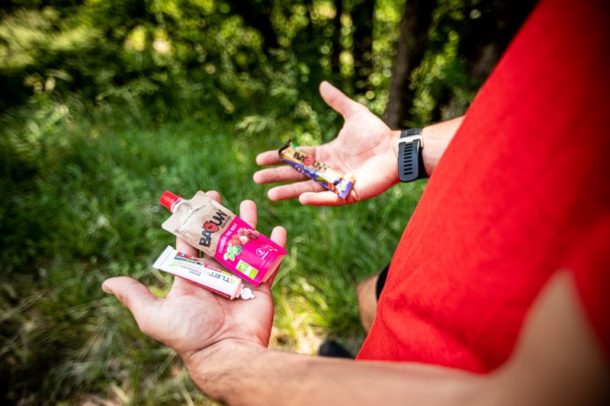
Opinions often vary when it comes to nutrition during exertion. On one side, there are proponents of energy bars; on the other, advocates for gels. But what exactly distinguishes these two options? To help you make an informed decision about whether to use energy gels or bars for nutrition in running or trail running, I will explore their respective advantages and disadvantages.
Contents
Nutrition during exertion: why is it important?
When you engage in prolonged physical activities such as running for miles, your body consumes energy. This energy comes from the food we eat, particularly from carbohydrates. The longer you engage in the activity, the more your carbohydrate reserves deplete. That’s where nutrition during exertion plays a crucial role, utilizing products designed to replenish your energy, such as gels and bars.
If you’re looking to understand the specifics of how and why to fuel yourself during a race, be sure to check out our detailed blog post on this topic.
Are energy gels a worthwhile bet?
Energy gels are popular among runners for good reason—they offer several benefits for consumption during races. Typically high in carbohydrates, gels provide a rapid energy boost which is essential during long-distance events.
Gels are convenient; they don’t melt or harden in different weather conditions. To use, simply tear open the packet and consume the gel for an instant dose of carbohydrates. Their semi-liquid form not only makes them easy to ingest but also contributes slightly to rehydration, thanks to the water and sodium in their ingredients. However, it is recommended to take them with a few sips of water to help dilute the sugar concentration, aiding both absorption and digestion.
Despite these advantages, the taste of energy gels can be off-putting for some. It’s wise to experiment with different brands to find one that suits your palate and doesn’t disrupt your focus on race day. For instance, Maurten gels are favored for their mild sweetness and efficiency, while Baouw‘s new natural gels offer an alternative with less processed ingredients.
However, energy gels do come with risks.
They contain a high concentration of sugars and may not suit everyone. Some runners might experience stomach cramps or nausea shortly after consumption. Digestive discomfort is a common challenge when eating during a race, making it crucial to test gels during training runs to ensure they agree with your stomach.

Energy bars: effective against energy slumps?
Energy bars are a reliable source of carbohydrates during exertion, offering a diverse range to suit any taste. However, it’s important to select the right type of bar.
Some are formulated for recovery, containing high levels of protein that may hinder digestion during physical activity and might not be necessary.
One of the main benefits of energy bars is their similarity to real food, which can be psychologically satisfying. Chewing a bar facilitates a gradual, more sustained release of energy. Additionally, bars typically have a lower glycemic index than gels, which helps maintain more stable blood sugar levels, providing a prolonged energy supply perfect for extended activities.
Despite these advantages, bars are not without their drawbacks.
They are less effective for quick energy needs. Their complex composition, often including cereals and dried fruits, can make them challenging to eat and digest during intense efforts like marathon running.
The consistency of bars can also vary with temperature changes: they may harden in cold weather, making them difficult to chew, or become sticky and messy in hot conditions, complicating consumption and handling. This variability can present a significant inconvenience under varying climatic conditions.
Verdict: gels or bars?
Choosing between energy gels and bars largely depends on personal preference and how well your body can digest these products during physical exertion. It’s crucial to test your nutrition under conditions similar to those you’ll encounter on race day to find what works best for you.
Gels are ideal for a quick carbohydrate boost—perfect for those moments when you need immediate replenishment. On the other hand, bars better suit longer efforts as they provide a more sustained energy release, thanks to their lower glycemic index and solid food format.
At RunMotion Coach, we often use both options to cover all bases. The strategy of combining gels and bars can offer the advantages of both quick energy and prolonged sustenance.
If you prefer not to choose between the two, another option is purees, which serve as a middle ground. For example, Baouw purees use natural ingredients to deliver carbohydrates efficiently and are incredibly palatable. This makes them a practical compromise, combining the best features of both gels and bars.
